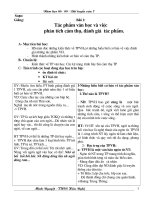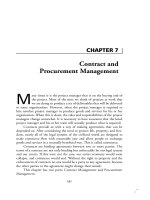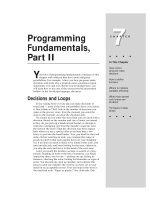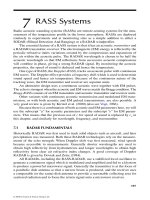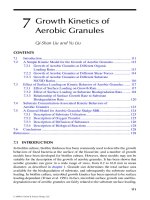Hedges on Hedge Funds Chapter 7 doc
Bạn đang xem bản rút gọn của tài liệu. Xem và tải ngay bản đầy đủ của tài liệu tại đây (226.52 KB, 17 trang )
CHAPTER
7
CHAPTER 7
Profiting from the
Corporate Life Cycle
T
his chapter will help investors understand the two most common
event-driven hedge fund strategies, risk arbitrage, and distressed
securities investing. The event-driven category is defined as strategies
that seek to profit principally from the occurrence of some of the typi-
cal events that occur in a corporate life cycle, such as mergers, acquisi-
tions, spin-offs, restructurings, and recapitalizations. (See Figure 7.1.)
In addition to risk arbitrage and distressed securities funds, the
event-driven strategy includes funds that are best classified as focusing
on special situations, although both risk arbitrageurs and distressed
securities funds frequently get involved in activities that do not fall con-
veniently within the mainstream definition of either strategy.
BETTING ON A TAKEOVER THROUGH
MERGER (RISK) ARBITRAGE
Investors in merger arbitrage, also called risk arbitrage, invest through
hedge fund managers who take a long position in the target company of
an announced takeover bid. In combination, where the consideration is
the stock of the acquirer, the arbitrageur generally will sell that stock
short. This strategy is analogous to the insurance business in that the
arbitrageur is insuring existing shareholders against the risk of the deal
not taking place. The spread between the market price and the offer
93
c07_hedges.qxd 8/30/04 12:08 PM Page 93
price is the equivalent of the insurance premium, which will be the
return to the arbitrageur should the deal proceed to completion.
The risk arbitrage strategy should be considered as part of an over-
all allocation to alternative investments because it provides benefits such
as low market correlation and a low standard deviation to an efficient,
diversified portfolio. In addition, risk arbitrage funds have returned
consistently strong profits to their investors for an extended period of
time, independent of overall market conditions.
Successful managers are experts at analyzing deals and taking into
account any possible regulatory obstacles and downside risks should the
deal fail to materialize. The possibility that the deal might not proceed
to completion is the key risk; and if managers have a strong view that a
deal will not proceed to completion, they can short the stock of the tar-
get company, an act that is known as a Chinese. The potential reward
in such cases is substantial, but constitutes only a small percentage of
total positions entered.
Risk arbitrage fund managers focus on companies involved in merg-
ers or acquisitions to take advantage of pricing inefficiencies in the
94 HEDGES ON HEDGE FUNDS
High Growth Mature Restructuring
Seed Capital Venture Investors
Scope of hedge fund arbitrage and
distressed opportunities
Public Offering
FIGURE 7.1 Corporate Life Cycle.
c07_hedges.qxd 8/30/04 12:08 PM Page 94
Profiting from the Corporate Life Cycle 95
shares of those companies. Fund managers can take long and short posi-
tions in both companies involved in a sale or merger to make profits.
Typically, arbitrageurs are long the stock of the company being acquired
and short the acquiring company.
A typical example of how risk arbitrage managers pursue returns
follows. When a company announces its intent to acquire or merge with
another company, typically there is a spread between the current mar-
ket price of the shares and the price to be paid for the shares in the deal,
because acquiring companies usually offer more than the current mar-
ket price to encourage the deal. At the time of the announcement, the
price of the target company rises to approach the offer price of the deal,
yet it will stop short of the offer price to reflect the uncertainty that the
deal will go through.
Risk arbitrage fund managers look to lock in this spread as a hedged
profit by going long and short in the appropriate shares. When the deal
is a trade of securities, the manager can lock in the spread by going
long in the stock of the target company and selling short the stock of the
acquiring company, which is done in case the purchaser’s stock price
falls. If the offer in the deal is a cash offer for stock, the manager sim-
ply goes long in the stock of the acquired company, without the need to
short the acquiring company.
The greatest risk facing event-driven strategies is when the antici-
pated event driving an investment fails to materialize. In the case of risk
arbitrage funds, this situation happens when an announced merger or
acquisition fails to be completed. Should the deal not be completed, the
stock price of the company being acquired will fall and significant losses
could occur for the arbitrage fund. Regulatory considerations are one of
the possible reasons for a deal to fall through. When two publicly traded
companies have entered into a deal, there is always the possibility that
antitrust regulators may disallow an acquisition after a review. One ex-
ample is when the European Union (EU) rejected the proposed merger
of General Electric and Honeywell in 2001. Merger arbitrageurs spe-
cialize in evaluating this risk to minimize the losses that can occur when
deals are not completed. Risk arbitrage managers also create diversified
portfolios of merger activity so as to reduce such specific event risk. (See
Figure 7.2.)
c07_hedges.qxd 8/30/04 12:08 PM Page 95
96 HEDGES ON HEDGE FUNDS
The level of risk undertaken by each arbitrage fund manager varies.
Some managers invest only in officially announced transactions, where-
as others undertake a higher level of risk by investing in positions at
an earlier stage, such as in rumored deals. Transactions undertaken at an
earlier stage offer a wider spread and therefore greater returns to com-
pensate for the increased risk. (See Figure 7.3.)
Most managers use a formal methodology in evaluating potential
risk. Quality research by fund managers and their staffs is an integral
part of the process and helps to reduce risk. A diversified portfolio con-
taining a large share of the transaction universe also helps managers to
reduce risk further. (See Figure 7.4.)
In recent years risk arbitrage funds have proven to be consistently
strong performers, even during periods of volatile market swings.
Announcement
of Intended Acquisition
Anticipated
Completion
$80 $100 $110
Offer Pric
e
Postannouncement
Price of
T
Preannouncement
Price of
T
SPREAD
• Fund managers take a long position in the stock of a
company being acquired in a merger, leveraged buyout,
or takeover and a simultaneous short position in the
stock of the acquiring company.
• If the takeover fails, this strategy may result in large
losses; if it is successful, it can result in large gains.
• Often risk is reduced by avoiding hostile takeovers
and by investing only in deals that are announced.
M&A Activity: Company B (the buyer) annouces offer to acquire
Company T (the target) at a share price of $110
FIGURE 7.2 Merger Arbitrage Example.
c07_hedges.qxd 8/30/04 12:08 PM Page 96
Profiting from the Corporate Life Cycle 97
Essentially, arbitrageur assumes the
risk that completion will be delayed or
will not occur.
Factors affecting
deal risk
Macro Risks
• Market
• Interest rates
• Other economic factors
• Earnings
•
Financing
• Legal
• Regulatory
• Timing
• Other
Micro Risks
0
2
3
4
5
Interest Rate Risk
Funding Liquidity
Risk
Leverage Risk
Grey = Plane of Risk
Legend
5 = high exposure
1 = low exposure
0 = no exposure
• Low interest rate
risk
• Low credit risk
• Performs well in
periods of high
corporate activity
• Increased in falling
equity markets
• Increased with
economic recession
Operational Risk
Counterparty Risk
Credit Risk
Equity Market Risk
Risk Exposure
• Interest rate risk - low
• Equity market risk - high
• Credit risk - low
• Counterparty risk - moderate
• Funding liquidity risk - moderate
• Leverage risk - moderate
• Operational risk - moderate
1
Merger arbitrage provides factor-specific exposure,
with moderate equity market beta.
FIGURE 7.3 Potential Risks in Merger Arbitrage.
FIGURE 7.4 Merger (Risk) Arbitrage Risk Profile.
c07_hedges.qxd 8/30/04 12:08 PM Page 97
Although returns for merger arbitrage funds were outpaced by the Stan-
dard & Poor’s (S&P) 500 during the broad market’s bull run of the
1980s and 1990s, merger arbitrageurs still were successful in generating
steady returns. One of the main attractions of this strategy is the sup-
posed low correlation to the equity markets; stock-specific events are
expected to be the main driver of performance, rather than directional
movements in the equity markets.
INVESTING IN DISTRESSED SECURITIES
Until recently, investors have overlooked distressed securities, and the
strategy is just now outgrowing its reputation as one of the most mis-
understood segments of the hedge fund universe. One reason some inves-
tors have not appreciated the opportunities to profit from distressed
securities investing is that investing in businesses experiencing financial
distress does not have the appeal of other investment strategies. The
results, however, more than make up for what it lacks in glamour and
continue to lead more investors into this strategy.
Distressed securities funds regularly produce exceptional investment
returns with relatively low volatility. In addition to being good risk-
adjusted investments, distressed securities funds have exhibited a very
low correlation to the performance of the broad market. The very low
correlation of distressed securities with the equity and fixed-income
markets can be explained by their transaction-based nature, which for
the most part operates independently of the current status of the mar-
98 HEDGES ON HEDGE FUNDS
Historical return
Historical volatility
Risk characteristics
Expected correlation
with equity markets
10%–12%
Low (4%–5%)
Conservative
Low (0.4)
FIGURE 7.5 Risk arbitrage at a glance.
Source: LJH Global Investments, LLC.
c07_hedges.qxd 8/30/04 12:08 PM Page 98
ket. Such low correlations make the distressed securities strategy an
excellent fit as part of a well-diversified portfolio. (See Figure 7.5.)
Distressed securities had an exceptional run in 2003 with the HFRI
Distressed Securities Index posting returns of 20.9 percent for the year.
The large postrecession supply of distressed companies followed by low
interest rates, favorable tax law changes, fiscal stimulus, and positive
gross domestic product growth provided the most favorable conditions
for the strategy since 1996. Even as interest rates increased midyear
2003, investors searching for yield continued to provide the driver for
many distressed securities managers to continue to generate returns until
year-end.
The bear market years of 2000 to 2002 only accelerated this process.
The bursting of the stock market bubble, the recession, widespread cor-
porate fraud, restatements of performance, and the impact of terrorism
on the travel industries resulted in motivated selling by institutions man-
aging credit exposure and losses and created significant market disloca-
tions and attractive pricing. Record levels of bankruptcy filings, debt
restructurings, and junk bond issuance in the United States in recent
years are a primary cause of today’s active secondary market in dis-
tressed securities. All in all, the increase in overall supply and diversity
of distressed corporate and small balance loan situations is higher than
investors have ever witnessed.
Overall, we believe that the distressed sectors will perform well in
the next few years as inflationary pressures push interest rates higher.
Performance for the strategy is not expected to repeat the high levels of
2003, but should still be respectable. We think investors should focus on
experienced managers who have been active in this strategy over the past
several years with a proven ability to maneuver through a less favorable
capital market environment. Highly leveraged companies that are not
successful at fixing their operational problems could very well experi-
ence cash flow problems and may be unable to deleverage if access to
the capital markets diminishes. Additionally, manufacturing companies
hurt by import substitutions or increased energy costs could be excluded
from the economic recovery. Distressed securities managers will need to
be cognizant of the potential for a wide variety of colliding trends—ris-
ing interest rates, falling currency costs, and rising energy costs—that
may impact the capital markets going forward, making investment op-
Profiting from the Corporate Life Cycle 99
c07_hedges.qxd 8/30/04 12:08 PM Page 99
portunities less plentiful and more difficult to identify. This fact again
points to the need for investors to exercise expert due diligence and
insist on intelligent transparency.
Today’s market is unique in both size and scope, including a broad
spectrum of distressed claims such as bank loans, debentures, trade
payables, private placements, real estate mortgages, legal damage claims,
and rejected lease contracts.
Distressed securities hedge funds invest specifically in the securities
of companies that are experiencing financial or operational difficulties.
The term “distressed securities” refers to a wide range of financial claims
on firms that either have filed for bankruptcy protection or are trying
to avoid bankruptcy by negotiating an out-of-court restructuring with
their creditors.
The recovery process of distressed companies generally involves sev-
eral major steps, and distressed securities managers may focus on spe-
cific areas in this process by extracting value when a catalyst or an event
that changes the price of the securities of the distressed companies occurs.
Hedge fund managers who specialize in distressed securities blend a
specialized knowledge of the bankruptcy process with fundamental analy-
sis of distressed companies and the intrinsic value of their debt securities
and equities that allows them to predict, and when necessary take actions
to influence, the outcome of the bankruptcies and reorganizations.
Distressed securities managers typically invest long and short in the
securities of companies undergoing bankruptcy or reorganization. They
tend to focus on companies that are undergoing financial rather than
operational distress—in other words, good companies with bad balance
sheets. Overleveraged companies that cannot cover their debt burden
become oversold when institutional bondholders liquidate their hold-
ings; as a result, as the companies enter bankruptcy, distressed securities
managers buy the positions at pennies on the dollar. Often the securi-
ties of these companies trade below their inherent value because of the
uncertainty of the companies’ future. Furthermore, traditional investors
often are restricted from owning the securities of companies with very
low credit ratings. As a result, hedge fund managers often can buy secu-
rities of sound companies with real assets that have not, for a variety of
technical reasons, been able to access the capital markets and delever-
100 HEDGES ON HEDGE FUNDS
c07_hedges.qxd 8/30/04 12:08 PM Page 100
age their balance sheets. Managers then look for the instruments to
appreciate or be exchanged for higher-valued securities at various points
as the company works its way through the restructuring process. Some
fund managers also hedge their portfolio by selling short the securities of
companies they believe will not restructure successfully and head toward
bankruptcy, as well as those that will not emerge from bankruptcy.
Distressed managers usually concentrate on certain sectors and
investing styles that fit their own expertise. Aspects that differentiate
distressed investing styles include the type of claim instrument invested
in (i.e., bank debt, corporate debt, trade claims, and equities), the phase
of the bankruptcy process, and the exit strategy used. Although the spe-
cific approaches are as diverse as the instruments and companies in
which distressed managers two main approaches to investing in dis-
tressed securities, passive and proactive, exist. (See Figure 7.6.)
Profiting from the Corporate Life Cycle 101
Participate in the
reorganization process
in a passive manner
without any major
influence
or exercise
of control
Proactive Strategies
Large institutions
Smaller specialized
distressed securities
investment firms
Take control of the
business
or play
spoiler in the
reorganization
process
Submitting a
reorganization plan
Purchasing currently
outstanding debt claims and
Purchasing new voting
stock
Objective of any of the plans is to influence or predict the
outcome of the reorganization process and to value the
assets of the firm correctly.
Passive Strategies
Possible means of gaining control
include:
Typical participants include:
FIGURE 7.6 Distressed Investing: Two Broad Substrategies.
c07_hedges.qxd 8/30/04 12:08 PM Page 101
Passive investors are those managers who simply purchase distressed
securities in the expectation that the reorganization plan carried out by
others will be successful and thus result in the appreciation of the secu-
rities owned. Holders of passive strategy investments include large insti-
tutions as well as smaller, specialized distressed securities investment
firms. Although opportunities for excess returns from passive strategies have
been reduced by the growth in the number of market participants, the in-
creased supply of distressed claims still makes a passive approach viable.
Proactive strategies entail varying levels of active involvement in the
reorganization process. They are more time consuming, labor intensive,
and costly to implement than passive strategies. Investment managers
utilizing proactive strategies must, therefore, selectively limit the focus
of their efforts. As a result, managers that engage in proactive strategies
will tend to have a more concentrated portfolio that embodies a greater
amount of unsystematic risk. These types of managers frequently have
in-house legal teams to fight for advantageous treatment of their class.
Approximately 90 percent of companies experiencing financial dis-
tress will try to restructure their debt before resorting to filing for bank-
ruptcy, and 50 percent of such companies will reach such an agreement.
Out-of-court restructurings are attractive to companies because they are
less expensive and pose less of a distraction than litigation. The equity
markets also value this approach and historically have rewarded suc-
cessful out-of-court restructurings.
Filing for Chapter 11 bankruptcy, however, can be beneficial for a
company experiencing severe financial distress. Under Chapter 11, the firm
does not have to pay or accrue interest on its unsecured debt or the
majority of its secured debt. The firm also may reject unfavorable lease
terms and borrow money from creditors that are given priority over
existing creditors. Unlike out-of-court settlements, Chapter 11 reorgan-
izations also can be accomplished without the unanimous approval of
creditors. A prepackaged Chapter 11 filing represents a combination
of various approaches. In a “prepack,” the company simultaneously
files for bankruptcy and presents a reorganization plan to creditors. The
benefit is a faster settlement; about 25 percent of distressed companies
use this approach. A plan of reorganization is essentially a proposal to
refinance the firm’s existing financial claims. In determining the value of
102 HEDGES ON HEDGE FUNDS
c07_hedges.qxd 8/30/04 12:08 PM Page 102
a claim, claimholders must consider both the absolute and the relative
reparation they are to receive under the proposed plan.
Proactive investors seek to profit either by redirecting the flow of cor-
porate resources to more highly valued uses or by bargaining for a larger
share of those resources by taking control of the business or by playing
the role of spoiler in the reorganization process. Three possible means
of gaining control are:
1. A reorganization plan can be submitted by either current manage-
ment or company claimholders. The plan specifies the manner in which
the firm’s assets will be divided among the claimants and therefore
can be written to favor one class of holders over another. Multiple
plans can be submitted and voted on to determine the final reorgani-
zation plan.
2. Outstanding debt claims often are purchased with the anticipation
that they will be converted into voting stock. When purchased in suf-
ficient quantity, this action can give control to the holders of the firm’s
assets after reorganization.
3. The purchase of new voting stock, referred to as funding the plan, can
give buyers control of the company and its assets, if they purchase suf-
ficient shares.
The purchase of currently outstanding equity prior to reorganiza-
tion is rarely an attractive option because of the dilution that occurs as
a result of any reorganization. The keys to any of these three strategies
are to influence or predict the outcome of the reorganization process
and value the firm’s assets correctly.
Control also can be exercised by establishing a blocking position in
any of the classes of claims. This strategy, called bond mail, involves
playing the spoiler by delaying approval of the reorganization plan.
Under Chapter 11, each class votes separately on whether to approve
the consensual reorganization plan under consideration. Approval by a
class of claimholders requires acceptance either by a two-thirds major-
ity in value or by one-half in number. By purchasing slightly more than
one-third of the value of claims in a single class, one investor sometimes
can block the reorganization plans in the hope of gaining a concession
Profiting from the Corporate Life Cycle 103
c07_hedges.qxd 8/30/04 12:08 PM Page 103
for the entire class. The ability to carry out this strategy effectively
depends on both the structure of the classes and the number and makeup
of claimholders. The reorganization plan can, however, sometimes be
crammed down (approved despite the objections of a single class).
The role of distressed investors (or vulture investors) in corporate
reorganizations is controversial. In the long run, if the distressed inves-
tors are deemed to be detracting value from the process, they will be
shut out. Many bankruptcy judges are philosophically opposed to the
idea that people can insert themselves into a distressed situation for
profit while the firm’s original lenders and stockholders are being asked
to make material financial sacrifices. Such hostility, however, overlooks
the critical role that investors play in creating value in a restructuring
situation. A key point to consider is that trading in distressed claims is
voluntary. Sellers participate in a given transaction only when they
expect to benefit from doing so. There exist numerous situations in
which original lenders can benefit from selling their claims. Further-
more, by buying and consolidating claims, distressed securities investors
can expedite the reorganization process by reducing holdouts and by
having the flexibility to enter the reorganization process from the point
of view of discount buyers.
Some distressed securities managers also invest in equity securities
that are issued at the end of the bankruptcy proceedings. These securi-
ties, called stub equities, often are overlooked by traditional investment
managers. Other distressed securities funds have moved into the loan
origination business. These managers have a more creative approach
to the market than traditional lenders and are willing to do the work
to accurately appraise unusual types of collateral. The loans are typi-
cally short term, highly collateralized, and very expensive. Lending rates
typically start at 15 percent. Although commonly viewed as a risky invest-
ment, volatility in stub equities actually varies with the strategies em-
ployed and the securities held. Volatility of returns is greatest among those
managers investing in high-yield debt and postbankruptcy stub equities.
Lower-volatility investments include late-stage investing in senior secured
debt. Financial leverage typically is not employed in this strategy.
The strategies for investing in distressed debt are many and varied.
However, investors who are consistently successful in this market tend
to exhibit superior skills in certain key areas:
104 HEDGES ON HEDGE FUNDS
c07_hedges.qxd 8/30/04 12:08 PM Page 104
■ Valuing assets, including locating, collecting, and analyzing
information
■ Negotiating and bargaining
■ Understanding the firm’s capital structure as well as the legal rights
and financial interests of all other claimholders
■ Risk management, including a thorough understanding of the spe-
cific risks associated with investing in distressed situations
The level of supply of distressed paper is a key determinant of prof-
itability in this strategy, as the level of pricing is determined by the supply
of investment opportunities in the market. As mentioned earlier, invest-
ment in this strategy entails the purchase or sale of securities at different
levels of the capital structure. As the supply of such securities increases
in the market, market dynamics force prices to be depressed, allowing
distressed investors to purchase these securities at deeper discounts.
The level of demand for distressed securities is also a key determi-
nant of profitability. Along with supply, demand plays a pivotal role in
determining pricing. Demand typically increases when distressed inves-
tors become more active in the strategy due to the level of opportunities
within the strategy. As the level of demand increases, there is less pric-
ing pressure, which allows credit spreads to tighten.
The rate of defaults is probably the most important driver, as it
has a direct impact on the supply of distressed investment opportunities
in the market. The default rate is driven by many factors, including
the state of the economy and credit markets in general. As the economy
enters a period of recession, companies become more prone to reduc-
tions in revenues and earnings. Providers of credit then become more
reluctant to provide credit, leaving companies unable to refinance
existing debt or finance business operations. Conversely, as the economy
improves, fewer companies default, reducing the overall supply of dis-
tressed situations.
One key strategy risk is the state of the economy. This strategy ben-
efits from a downturn in the economy, as more investment opportuni-
ties become available in such a market environment. However, if the
economic downturn is prolonged, then the recovery of these companies
may be protracted or put at risk. An improvement in operating per-
formance is contingent not only on an issuer’s ability to raise cash,
Profiting from the Corporate Life Cycle 105
c07_hedges.qxd 8/30/04 12:08 PM Page 105
deleverage, and restructure but also depends on currency, interest rates,
and commodity price movements.
Distressed managers also face the risk of fraud. Thorough due dili-
gence and risk management procedures will help protect their invest-
ments, but risk can never be eliminated entirely. (See Figure 7.7.)
Another risk is that companies cannot navigate the corporate
restructuring process successfully and that certain securities do not per-
form as anticipated at the conclusion of the reorganization. A number
of people, including bondholders, bankers, equity holders, lawyers, and
judges, are involved as each company works through the restructuring
process. As a result, it can be difficult to determine which group of
investors will come out on top. However, in the United States, bank-
ruptcy laws are in place to give investors a fairly good sense of the prob-
abilities for the different potential outcomes.
106 HEDGES ON HEDGE FUNDS
• Buying cheap prior to restructuring “exit catalysts”
• Regulatory arbitrage
• High alpha (verses equity indices)
• Moderate beta (generates returns with long bias and
some downside risk)
• High returns with medium risk
• Factor-specific exposure
• Long bias
• Average year: 18.07% Worst year: 1998 (−4.23%)
Strategy Intention
Source of Profits
Risk Return Profile
Role in Portfolio
Risk Exposure
•
Generate profits from securities undervalued relative to
both the economic value of the firm and the projected
value of the firm’s other debt instruments
• Interest rate risk: moderate
• Equity market risk:
high
• Credit risk:
high
•
Counterparty risk:
high
•
Funding liquidity risk:
high
•
Leverage risk:
moderate
•
Operational risk:
moderate
Worst-Case Factors:
• Widening credit spreads
• Recessionary years
•
Restricted capital markets
Favorable:
•
Years following recession
•
Equity-friendly environments
•
Significant supply of distressed debt
Scenario Factors
Distressed investing provides factor-specific exposure,
with moderate equity market beta.
FIGURE 7.7 Distressed Investing Strategy Profile.
c07_hedges.qxd 8/30/04 12:08 PM Page 106
The 2000 to 2002 surge in distressed securities on the market cre-
ated a supply/demand imbalance offering a multitude of good opportu-
nities for investors, much like the recession-era early 1990s, which
brought strong returns for distressed securities funds. (See Figure 7.8.)
By most accounts, the U.S. economy is expected to grow at around
a 4 percent rate in 2004. There is strong evidence that employment is
improving, and despite an expected slowdown in consumer spending,
capital spending is expected to take up the slack given the improved cor-
porate balance sheets. There are still some potential factors that could
slow growth—in particular geopolitical risks or an extended decrease in
consumer spending. However, despite these risks, it appears that the
economic recovery will be sustained, and inflationary pressures from a
falling dollar and fiscal deficits will most likely slow the Federal Reserve
from its accommodating stance to tightening.
Distressed securities should have another positive year in 2004,
albeit not at the rates of 2003. Due to the historic levels of corporate
defaults in recent years, a large number of bankrupt companies are
progressing through the restructuring process. Thus a good supply of
Profiting from the Corporate Life Cycle 107
Grey = Plane of Risk
Legend
5 = high
exposure
1 = low
exposure
0 = no exposure
• Increased with rapidly
rising interest rates
• Increased with widening
credit spreads
• Perform poorly in
recessions
• Increased with poor
economic conditions
• Does better in equity
friendly environments
Equity Market Risk
Interest Rate Risk
Funding Liquidity Risk
Leverage Risk
Operational Risk Counterparty Risk
Credit Risk
0
1
2
3
4
5
The dominant risks in distressed securities are credit spreads
and illiquidity of investments.
FIGURE 7.8 Distressed Investing Risk Profile.
c07_hedges.qxd 8/30/04 12:08 PM Page 107
investment opportunities in companies in late-stage bankruptcy should
continue. These securities often can appreciate rapidly as the bankruptcy
process approaches its resolution and the intrinsic value is realized.
Additionally, managers have noted that the move in the capital mar-
kets from traditional lenders to the less restrictive, more flexible high-
yield markets may extend the distressed investing cycle. Companies
rescued by the available financing that do not fix their operational prob-
lems most likely will continue to experience problems going forward.
Looking ahead, one concern for the distressed securities strategy is
a tightening of the credit cycle with rising interest rates. Higher rates
will increase the costs of funding and can result in some mark-to-market
losses, but also may result in a repricing of some securities, resulting in
lower entry points for investments.
In 2003 multistrategy managers were drawn to the distressed invest-
ing strategy to capitalize on the investment opportunities as the demand
for high yield helped push returns higher. The increased number of man-
agers investing in distressed securities may have more of an adverse
effect in late 2004 as supply of distressed paper begins to diminish with
the recovering economy and as interest rates begin to climb.
108 HEDGES ON HEDGE FUNDS
TIPS
Event-driven hedge funds seek to profit from occurrences that are
part of the corporate life cycle, such as mergers, acquisitions, spin-
offs, restructurings, and recapitalizations. Investors can bet on a
corporate takeover through the risk (or merger) arbitrage strategy,
for example, or can seek to profit from an investment in distressed
securities. It is likely that the distressed sectors will perform well
in the next few years as inflationary pressures push interest rates
higher, and investment in this sector should not be overlooked.
■ Focus on experienced hedge fund managers who have been
active in the event-driven strategy for at least several years and
who have a proven ability to maneuver through less than favor-
able capital market environments.
c07_hedges.qxd 8/30/04 12:08 PM Page 108
Profiting from the Corporate Life Cycle 109
■ Risk arbitrage hedge fund managers focus on companies in-
volved in mergers or acquisitions to take advantage of pricing
inefficiencies in shares of those companies. Therefore, investors
should be sure that managers are expert at analyzing deals
and taking into account the possible regulatory obstacles and
downside risks that could occur if a deal fails to materialize.
■ Ask about the level of risk undertaken by fund managers, and
recognize that some managers invest only in officially announced
transactions, whereas others undertake a higher level of risk
by investing in speculative positions at an earlier stage, such as
in rumored deals.
■ Remain cognizant of the potential for a wide variety of collid-
ing trends, such as rising interest rates, falling currency rates,
and rising energy costs, which may impact the capital markets
going forward and making investment opportunities less plen-
tiful and more difficult to identify.
■ Increase your understanding of the bankruptcy process as well
as the basics of fundamental analysis of distressed companies
so you can do the proper due diligence on hedge fund managers
in this strategy.
■ Understand the role of passive versus active distressed securities
investing (the latter are managers who get actively involved in
the reorganization process).
■ Know how to value assets, including locating, collecting, and
analyzing information.
■ Understand the nuances of negotiating and bargaining.
■ Evaluate the firm’s capital structure as well as the legal rights
and financial interests of all other claimholders.
■ Thoroughly understand the specific risks associated with in-
vesting in distressed situations.
c07_hedges.qxd 8/30/04 12:08 PM Page 109
